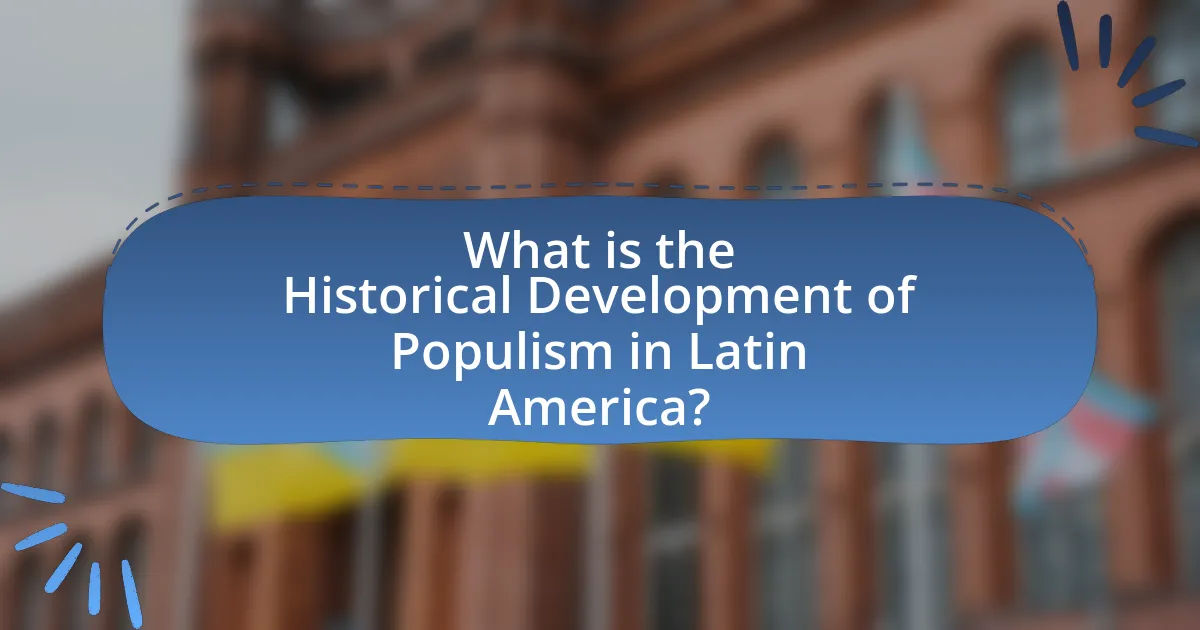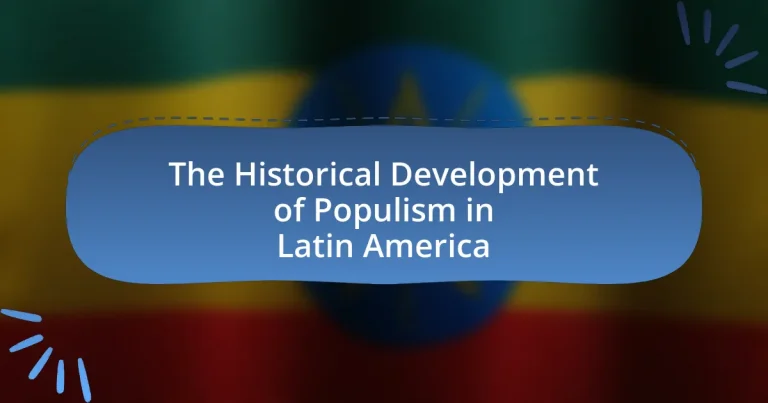The article examines the historical development of populism in Latin America, tracing its origins to the early 20th century and highlighting key figures such as Juan Domingo Perón in Argentina and Hugo Chávez in Venezuela. It discusses the socio-economic inequalities, political instability, and the influence of external powers that contributed to the rise of populist movements. The article also outlines the defining characteristics of populism, its evolution in contemporary politics, and the challenges faced by populist leaders today. Additionally, it explores the role of nationalism, media, and economic crises in shaping public perception and the stability of populist governments, providing insights into the lessons learned from historical populist movements in the region.

What is the Historical Development of Populism in Latin America?
The historical development of populism in Latin America began in the early 20th century, characterized by leaders who claimed to represent the common people against the elite. Notable examples include Juan Domingo Perón in Argentina during the 1940s, who utilized labor movements and social welfare programs to gain support. The phenomenon continued through the late 20th century with figures like Hugo Chávez in Venezuela, who employed rhetoric of anti-imperialism and social justice to mobilize the masses. The rise of populism in Latin America is often linked to socio-economic inequalities, political instability, and the influence of external powers, particularly the United States. These factors have shaped the region’s political landscape, leading to a cyclical pattern of populist movements that respond to the needs and frustrations of the populace.
How did populism emerge in Latin America?
Populism emerged in Latin America primarily in the early to mid-20th century as a response to social inequalities and political exclusion. Economic crises, such as the Great Depression, exacerbated existing disparities, leading to widespread discontent among the working and middle classes. Leaders like Juan Domingo Perón in Argentina and Getúlio Vargas in Brazil capitalized on this discontent by promoting nationalist and reformist agendas that appealed directly to the masses, often bypassing traditional political elites. The rise of mass media, particularly radio, facilitated the direct communication of these leaders with the populace, further solidifying their support. Historical evidence shows that these populist movements often sought to redistribute wealth and empower marginalized groups, fundamentally reshaping the political landscape in their respective countries.
What historical contexts contributed to the rise of populism?
The rise of populism in Latin America was significantly influenced by socio-economic inequalities, political instability, and the legacy of colonialism. Socio-economic disparities, particularly during the early to mid-20th century, created a fertile ground for populist leaders who promised to address the needs of the marginalized. For instance, the Great Depression in the 1930s exacerbated economic hardships, leading to widespread discontent and the emergence of leaders like Getúlio Vargas in Brazil, who implemented policies aimed at social welfare and labor rights. Political instability, characterized by military coups and authoritarian regimes, further fueled populist sentiments as leaders sought to rally popular support against perceived elites. Additionally, the historical context of colonialism left a legacy of disenfranchisement among indigenous and rural populations, which populist movements capitalized on to gain traction. These factors collectively contributed to the rise of populism as a response to the socio-political landscape in Latin America.
Who were the key figures in the early populist movements?
Key figures in the early populist movements in Latin America included Juan Domingo Perón in Argentina, Getúlio Vargas in Brazil, and Lázaro Cárdenas in Mexico. Juan Domingo Perón, who served as President of Argentina, implemented policies that favored labor rights and social welfare, significantly influencing the working class. Getúlio Vargas, as President of Brazil, promoted nationalism and industrialization, establishing a populist regime that appealed to the masses. Lázaro Cárdenas, President of Mexico, is known for land reforms and nationalizing the oil industry, which garnered widespread support among peasants and workers. These leaders exemplified the populist approach by prioritizing the needs of the common people over elite interests.
What are the defining characteristics of populism in Latin America?
The defining characteristics of populism in Latin America include a strong leader who claims to represent the “common people,” a focus on anti-elitism, and the use of direct appeals to the masses. These leaders often position themselves against established political elites and institutions, claiming to restore power to the people. Historical examples include figures like Juan Domingo Perón in Argentina and Hugo Chávez in Venezuela, who utilized charismatic authority and mass mobilization to gain support. Additionally, populism in Latin America frequently involves economic policies aimed at redistributing wealth and addressing social inequalities, as seen in the implementation of social welfare programs during the presidencies of these leaders.
How does populism differ from other political ideologies?
Populism differs from other political ideologies primarily in its focus on the dichotomy between “the people” and “the elite.” Unlike ideologies such as liberalism or socialism, which emphasize specific economic or social structures, populism centers on the idea that society is divided into two antagonistic groups: the virtuous common people and the corrupt elite. This distinction drives populist movements to claim they represent the will of the people against established institutions and elites, often using charismatic leadership to mobilize support. Historical examples in Latin America, such as Juan Domingo Perón in Argentina, illustrate how populist leaders have utilized this framework to gain power by appealing directly to the masses, bypassing traditional political channels.
What role does nationalism play in Latin American populism?
Nationalism plays a crucial role in Latin American populism by fostering a sense of collective identity and unity among the populace, which populist leaders exploit to gain support. This connection between nationalism and populism is evident in the rhetoric of leaders like Juan Domingo Perón in Argentina and Hugo Chávez in Venezuela, who emphasized national sovereignty and cultural pride to mobilize the masses against perceived external threats and elite interests. Historical contexts, such as the struggle against colonialism and foreign intervention, have further solidified nationalism as a foundational element of populist movements, allowing leaders to frame their agendas as a defense of national interests.
What major populist movements have shaped Latin American history?
Major populist movements that have shaped Latin American history include Peronism in Argentina, the Brazilian Workers’ Party, and the Bolivian Movement for Socialism. Peronism, initiated by Juan Domingo Perón in the 1940s, emphasized social justice and labor rights, significantly influencing Argentine politics and society. The Brazilian Workers’ Party, founded in the 1980s, focused on social equality and workers’ rights, leading to the election of Luiz Inácio Lula da Silva in 2002, which marked a shift towards leftist policies in Brazil. The Bolivian Movement for Socialism, led by Evo Morales since 2006, aimed to empower indigenous populations and nationalize key industries, reshaping Bolivia’s political landscape. Each of these movements has left a lasting impact on their respective countries, reflecting the broader trends of populism in the region.
What impact did Juan Domingo Perón have on populism in Argentina?
Juan Domingo Perón significantly shaped populism in Argentina by establishing a political movement that emphasized the empowerment of the working class and the importance of a strong, charismatic leader. His presidency from 1946 to 1955 introduced policies that favored labor rights, social welfare, and economic nationalism, which resonated with the masses and fostered a sense of identity among the Argentine people. Perón’s use of mass media, particularly radio, allowed him to communicate directly with citizens, bypassing traditional political elites and reinforcing his populist appeal. His legacy includes the creation of a political culture that prioritized the needs of the working class, which has influenced subsequent populist leaders in Argentina and across Latin America.
How did the Cuban Revolution influence populist ideologies in the region?
The Cuban Revolution significantly influenced populist ideologies in Latin America by providing a successful model of anti-imperialist and socialist governance. This revolution, which culminated in 1959, inspired various leftist movements across the region, encouraging leaders to adopt populist rhetoric that emphasized social justice, land reform, and the redistribution of wealth. For instance, figures like Che Guevara and Fidel Castro became symbols of resistance against U.S. intervention, prompting other leaders such as Hugo Chávez in Venezuela to embrace similar populist strategies that sought to empower the marginalized and challenge established elites. The revolution’s emphasis on grassroots mobilization and national sovereignty resonated throughout Latin America, leading to a wave of populist governments that aimed to address economic inequalities and promote social welfare.
How has populism evolved in contemporary Latin America?
Populism in contemporary Latin America has evolved through a resurgence of leftist leaders who emphasize social justice and anti-establishment sentiments. This shift is marked by the rise of figures such as Hugo Chávez in Venezuela and Evo Morales in Bolivia, who leveraged populist rhetoric to mobilize support among marginalized populations. The economic crises and social inequalities in the region have further fueled this evolution, leading to a rejection of traditional political elites and the embrace of leaders who promise to represent the “common people.” For instance, according to a 2020 study by the Latin American Public Opinion Project, there has been a significant increase in support for populist parties, reflecting widespread discontent with neoliberal policies and corruption.
What are the current trends in populist leadership across Latin America?
Current trends in populist leadership across Latin America include a rise in anti-establishment sentiments, increased polarization, and the use of social media for direct communication with supporters. Leaders such as Andrés Manuel López Obrador in Mexico and Jair Bolsonaro in Brazil exemplify this trend by positioning themselves against traditional political elites and utilizing populist rhetoric to mobilize their bases. Additionally, economic crises and social inequality have fueled the appeal of populist leaders, as they promise to address the grievances of marginalized populations. The 2021 elections in Peru and Chile further illustrate this trend, where candidates with populist platforms gained significant support, reflecting a broader discontent with conventional political structures.
How do modern populist movements address social inequality?
Modern populist movements address social inequality by advocating for policies that redistribute wealth and empower marginalized groups. These movements often emphasize the need for social justice, economic reforms, and increased access to resources for the lower and middle classes. For instance, leaders like Evo Morales in Bolivia implemented policies aimed at nationalizing key industries and increasing social spending, which significantly reduced poverty rates from 38.2% in 2005 to 15.2% in 2018. Similarly, in Argentina, populist policies under leaders like Cristina Fernández de Kirchner focused on social welfare programs that aimed to alleviate poverty and improve living standards, contributing to a decrease in the poverty rate from 54% in 2002 to around 25% in 2015. These examples illustrate how modern populist movements actively seek to combat social inequality through targeted economic and social policies.
What challenges do populist movements face today?
Populist movements today face significant challenges, including political fragmentation, economic instability, and public disillusionment. Political fragmentation arises as diverse factions within populist movements struggle to maintain unity, often leading to infighting and weakened electoral power. Economic instability, exacerbated by global crises such as the COVID-19 pandemic, undermines populist promises of prosperity, causing voter dissatisfaction. Public disillusionment occurs when populist leaders fail to deliver on their promises, leading to a decline in support. For instance, in countries like Venezuela and Argentina, economic crises have diminished the effectiveness of populist rhetoric, demonstrating the tangible impact of these challenges on their viability.
How do economic crises affect the stability of populist governments?
Economic crises significantly undermine the stability of populist governments by eroding public support and exposing governance failures. During economic downturns, populist leaders often struggle to fulfill their promises of economic improvement, leading to disillusionment among their supporters. For instance, in Argentina, the economic crisis of 2001 resulted in the collapse of the populist government led by Fernando de la Rúa, as widespread unemployment and poverty fueled public protests and demands for change. Similarly, in Venezuela, the economic turmoil exacerbated by falling oil prices in the mid-2010s weakened Nicolás Maduro’s regime, leading to increased opposition and civil unrest. These examples illustrate that economic crises can catalyze a loss of legitimacy for populist governments, ultimately threatening their survival.
What role does media play in shaping public perception of populism?
Media plays a crucial role in shaping public perception of populism by influencing narratives and framing political discourse. Through selective coverage, media outlets can amplify populist messages, portraying leaders as champions of the common people against elite interests. For instance, during the rise of populist leaders in Latin America, such as Hugo Chávez in Venezuela, media portrayal significantly impacted public support, as Chávez utilized state media to disseminate his populist rhetoric while criticizing opposition media as part of the elite. Studies have shown that media representation can sway public opinion, with surveys indicating that favorable media coverage correlates with increased approval ratings for populist leaders. Thus, the media acts as a powerful tool in constructing and reinforcing the public’s understanding of populism.
What lessons can be learned from the historical development of populism in Latin America?
The historical development of populism in Latin America teaches that populist movements often arise in response to social inequalities and political disenfranchisement. These movements, exemplified by leaders like Juan Domingo Perón in Argentina and Getúlio Vargas in Brazil, demonstrate how charismatic leadership can mobilize the masses and challenge established elites. Furthermore, the cyclical nature of populism reveals that while it can address immediate grievances, it may also lead to authoritarianism and economic instability, as seen in Venezuela under Hugo Chávez. This pattern underscores the importance of institutional checks and balances to sustain democratic governance and prevent the concentration of power.
How can understanding populism inform future political strategies?
Understanding populism can inform future political strategies by highlighting the importance of addressing the concerns of marginalized groups and the need for leaders to connect emotionally with the electorate. Historical examples, such as the rise of leaders like Juan Domingo Perón in Argentina, demonstrate that populist movements often gain traction by promising to represent the “common people” against perceived elites. This connection can be leveraged in future strategies by emphasizing inclusive policies and direct communication that resonate with voters’ experiences and aspirations. Additionally, recognizing the cyclical nature of populism, as seen in various Latin American countries, allows political strategists to anticipate shifts in public sentiment and adapt their approaches accordingly, ensuring they remain relevant and responsive to the electorate’s evolving needs.
What best practices can be derived from successful populist movements?
Successful populist movements often employ best practices such as strong charismatic leadership, clear anti-establishment messaging, and the ability to mobilize grassroots support. Charismatic leaders, like Hugo Chávez in Venezuela, effectively connect with the populace, creating a sense of personal loyalty and trust. Anti-establishment messaging resonates with citizens feeling marginalized by traditional political elites, as seen in the rise of populist leaders who challenge the status quo. Additionally, grassroots mobilization is crucial; movements that engage communities through local organizations and social networks can build a robust support base, exemplified by the Workers’ Party in Brazil, which utilized local activism to gain electoral success. These practices demonstrate how successful populist movements can effectively engage and mobilize their constituents.


